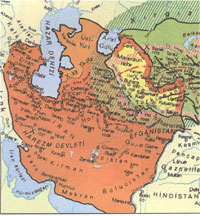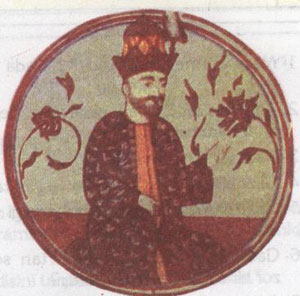- Articles Index
- Monthly Features
- General History Articles
- Ancient Near East
- Classical Europe and Mediterranean
- East Asia
- Steppes & Central Asia
- South and SE Asia
- Medieval Europe
- Medieval Iran & Islamic Middle East
- African History (-1750)
- Pre-Columbian Americas
- Early Modern Era
- 19'th Century (1789-1914)
- 20'th Century
- 21'st Century
- Total Quiz Archive
- Access Account
The Khwarezm-Shâh Empire
Category: Islamic Civilizations
Author: Ihsan The Founding
Atsiz was a ruthless ruler; he laid heavy taxes on the people and began capturing strategic positions of the region. Sanjar organized three campaigns on Atsiz, and even tough Atsiz's forces were defeated, Sanjar let him to govern the region, because a new danger was coming from the Steppes: the Kara-Khitai. After Sanjar's army was crushed by these nomadic people at the Battle of Qatwan in 1141, Atsiz declared his independece but he submitted the Seljuk protectorate after Sanjar escaped from the rebel Oghuz. After Atsiz died in 1156, he was succeded by his son Il-Arslan. Rise to Power After Sanjar's death in 1157, Il-Arslan proclaimed his independence, defeated the Kara-Khitai and the Qarakhanids and captured important Transoxian towns like Bukhara and Samarkand. He died in 1172 and his son Alaeddin Takish became the new Khwarezm Shah. Alaeddin Takish was a brilliant ruler and a good general. He defeated the Kara-Khitai and brought the Kipchaks under Khwarezmshah rule. He invaded Khorasan in 1183 and destroyed the Iraqi Seljuks in 1194. He spent his last years in fighting with the Assassins and captured the fort of Arslan-Gusha, one of their most important strongholds. He died in 1200 and his son Alaeddin Mohammed sat on the Khwarzemshah throne. The early years of Alaeddin Mohammed's reign were spent for the struggle against the other Khwarezmshah princes. In 1214, he destroyed the Kara-Khitai Empire and the Gurid Sultanate of India. He also expanded the borders of the empire up to the Persian Gulf. Another campaign he was planning was the Invasion of China; altough China was already invaded by the Mongols
Collapse of the Empire
Now, there was a new power rising in the East: the Mongols commanded by Genghis Khan. In order to learn more about the power of the Mongols, Alaeddin Mohammed sent an envoy to Karakurum, the Mongol capital, and signed a treaty with him. After this, Genghis Khan sent a caravan to Otrar, but the Mongol merchants were massacred by Inaljik, the governor of that town, who also humiliated the Mongol emissaries. As a result, Genghis Khan invaded Transoxiana with his army. Even tough the Mongol army was outnumbered, Alaeddin Mohammed divided his army into small garrisons, a mistake which allowed Genghis Khan to capture important cities like Bukhara, Samarkand, Jend, Khokand and Urgench easily. Alaeddin Mohammed fled to a small Caspian island and died there in 1220. Jalal-Al-Din Khwarezmshah became the new shah but his forces were defeated at the Battle of River Indus. He fled to Azerbaijan, attacked Rum Seljuk towns in Eastern Anatolia and captured Ahlat, an important Seljuk town. He was defeated by the Rum Seljuk Sultan Alaeddin Qaykubad I at the Battle of Yassi Chemen in 1230, and he was murdered in 1231. With his death, the Khwarzemshah Empire came to an end. Emperors Qudbaddin Mohammed (1098 - 1128) Atsiz (1128 - 1156) Il-Arslan (1156 - 1172) Sultanshah (1172 - 1193) Alaeddin Takish (1172 - 1200) Alaeddin Mohammed (1200 - 1220) Jalal-Al-Din Khwarezmshah (1220 - 1231) Chronology 1098: Qudbaddin Mohammed appointed governor of Khwarezm 1141: Atsiz proclaimed his independence but submitted to the Seljuk rule soon 1157: Il-Arslan proclaimed his independence 1183: Alaeddin Takish invaded Khorasan 1194: Alaeddin Takish destroyed the Iraqi Seljuks 1214: Alaeddin Mohammed destroyed the Kara-Khitai Empire and the Gurid Sultanate 1218: Alaeddin Mohammed signed a treaty with Genghis Khan 1220: Mongol merchants are massacred in Otrar; Mongol emissaries executed in Urgench; Genghis Khan's invasion of Transoxiana and Khorasan; death of Alaeddin Mohammed 1221: Battle of River Indus 1230: Jalal-Al-Din Khwarezmshah captured Ahlat; his forces are defeated at the Battle of Yassi Chemen 1231: Jalal-Al-Din Khwarzmshah murdered; the Khwarezmshah Empire collapsed. |




